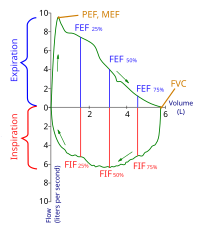
Photo from wikipedia
Elevated respiratory muscle work is encountered during strenuous exercise, acute and chronic respiratory disorders and during inspiratory pressure-threshold loading (ITL). ITL can induce respiratory muscle damage, evidenced by increases in… Click to show full abstract
Elevated respiratory muscle work is encountered during strenuous exercise, acute and chronic respiratory disorders and during inspiratory pressure-threshold loading (ITL). ITL can induce respiratory muscle damage, evidenced by increases in fast and slow skeletal troponin-I (sTnI). However, other blood markers of muscle damage have not been measured. We investigated respiratory muscle damage following ITL using a skeletal muscle damage biomarkers panel. Seven healthy men (33±2 years) undertook 60 min of ITL at a resistance equivalent to ~0% (Sham ITL) and 70% of their maximal inspiratory pressure two weeks apart. Serum was collected before and at 1, 24, and 48 h after each ITL session. Creatine kinase muscle-type (CKM), myoglobin, fatty acid-binding protein-3 (FABP3), myosin light chain-3, and fast and slow sTnI were measured. Two-way ANOVA revealed time x load interaction effects (P<0.05) for CKM, slow and fast sTnI. All of these were higher for 70% compared to Sham ITL. CKM was higher at 1 and 24 h, fast sTnI at 1 h, while slow sTnI was higher at 48 h. There were main effects of time (P<0.01) for FABP3 and myoglobin, but no time x load interaction effects. Hence, CKM and fast sTnI could be used to assess respiratory muscle damage immediately (1 h), while CKM and slow sTnI could be used to assess respiratory muscle damage 24 and 48 h following conditions that elevate inspiratory muscle work. The specificity of these markers for different time points needs further exploration in other protocols that cause elevated inspiratory muscle work.
Journal Title: Journal of applied physiology
Year Published: 2023
Link to full text (if available)
Share on Social Media: Sign Up to like & get
recommendations!